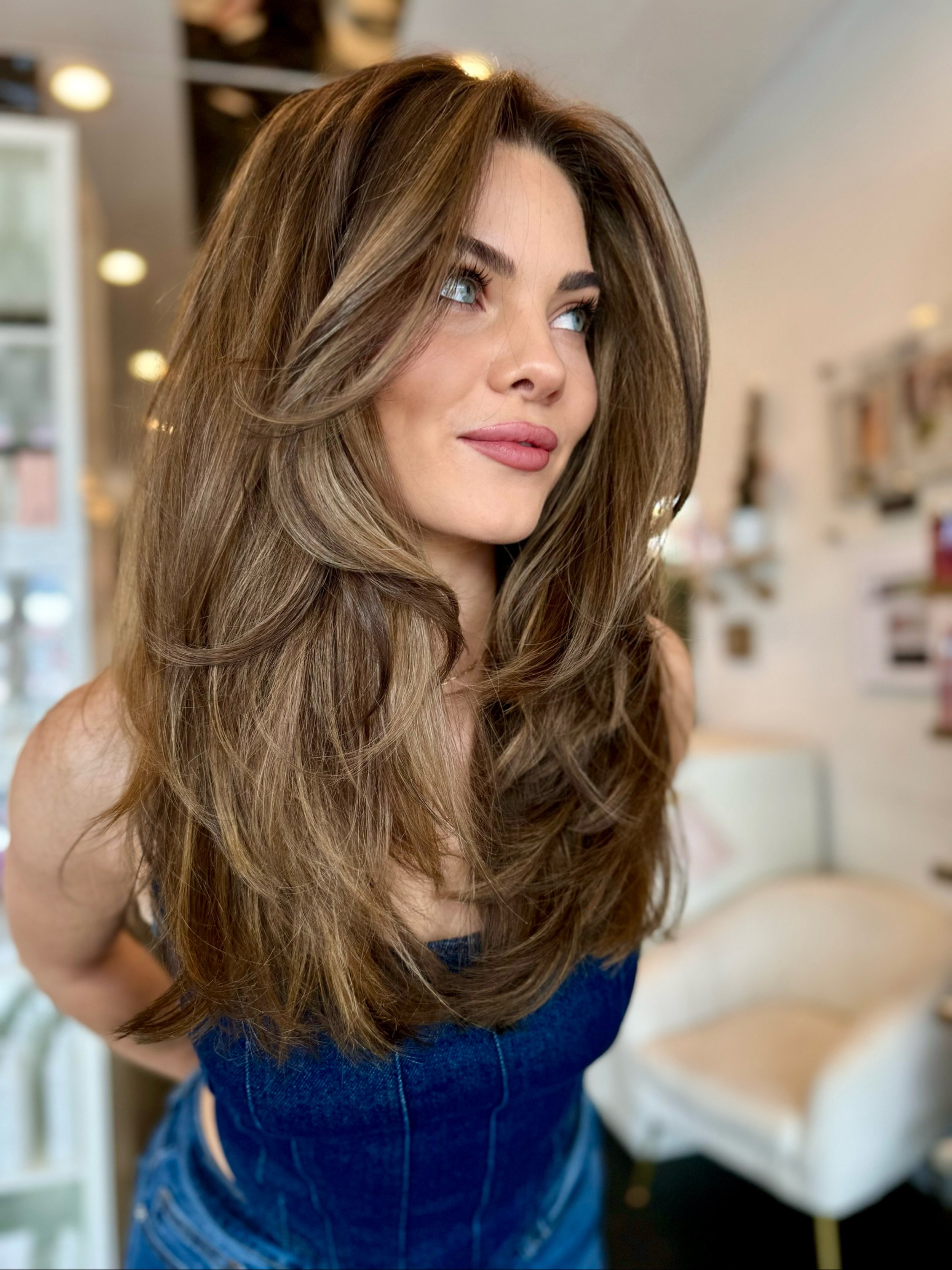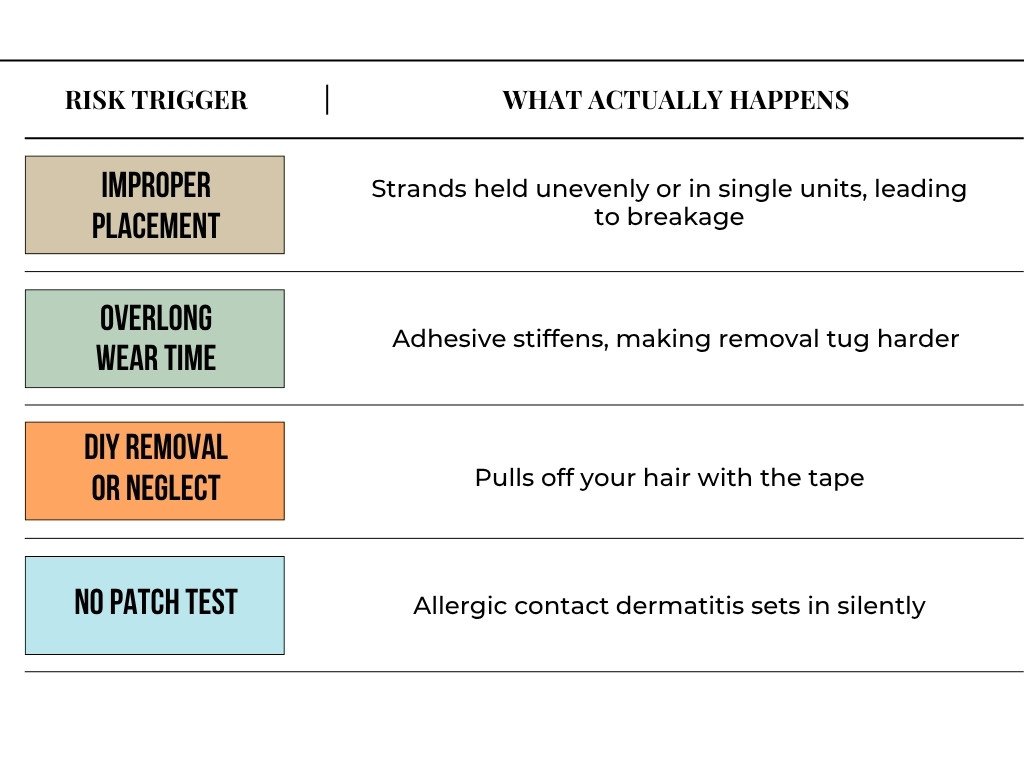Are Tape In Extensions Bad for Your Hair? Risks Uncovered
Are tape in extensions bad for your hair?
It’s a fair question — one that sounds simple, until you’re deep in a rabbit hole of “influencer secrets” and salon silence. You’ve probably heard: they’re featherlight, they’re seamless, they’re safe when “installed properly.” Cute. But let’s cut the fluff.
You don’t need another “it depends” from someone trying to sell you a service. What you need is someone who’ll say what others won’t: tape-ins can wreck your hair — and not because they’re inherently evil, but because no one talks about the invisible damage until you’re Googling bald spots at 2AM.
We’re not here to scare you off. We’re here to hand you the kind of info that protects your scalp before your stylist pretends it’s your shampoo’s fault.
What Are Tape-In Extensions and How Do They Work?
Let’s start with the basics. Tape-in extensions are ultra-thin wefts of hair—like tiny rugs—that your stylist glues onto small slices of your natural hair using medical-grade adhesive tapes. They’re sandwiched: one extension weft under your hair, one on top, sealing your hair like a protein bar between edible wrappers. That is how tape extensions work in real life—no knots, no heat—just direct tape-to-hair contact.
They typically, if you’re diligent, last six to eight weeks before needing a move-up. The tape is reusable, but only after you and your stylist apply a proper adhesive remover solution. Remove them too early, and they fall off. Too late? You risk too much grip—and that’s where things can go sideways.
Why are they so popular?
They lay flat, look natural, and take less than an hour to install—no scalp-disrupting braids or hot keratin. Many clients choose tape-ins because they deliver length and volume without the heaviness of sew-ins or risk of heat damage typical of fusion bonds. They promise a sleek, seemingly seamless upgrade.
But just because they feel “invisible” doesn’t mean they behave that way. The adhesive holds your hair and the extension in a micro-vice— even if it doesn’t pinch. That tension, cumulative over weeks, can stress the hair shaft.
Potential Risks of Tape-In Extensions: Do They Damage Your Hair?
Let’s face the real question: do tape in extensions damage hair?
The short answer is… sometimes yes—especially when style meets neglect. We'll break down the headache-inducing ways tape-ins can cause harm.
Hair Breakage
Breaking isn’t always about weight. It's about stress concentration. When extensions are improperly applied, the tape might grip only strands, rather than hair clusters. Pull too much or yank during removal, and you snap strand by strand. A London case study found badly fitted extensions—whether tape, glue, or rings—can cause visible hair loss from scalp tension
Traction Alopecia
This one is diagnosed hair loss caused by persistent pull on follicles. Dermatologists report traction alopecia frequently in extension wearers. It often starts at hairlines or temples—classic tape-in zones. And yes, it's reversible if caught early—but ongoing misuse can leave lasting damage.
Scalp Irritation and Allergies
You might love lighter, stronger tape, but your scalp could think it’s poison. Some adhesives aren’t meant to touch your skin. A study even listed dermatitis and flaking as common in tape-wearers. Brands emphasize medical-grade tapes, but that doesn’t guarantee patch tests or complaints-free wear.
Thinning in Fine or Weak Hair
Extensions are like extra weight on a shaky bridge. If your hair is fine or already weak, that little tape tab can accelerate thinning. In people with compromised hair health, tape-ins score high-risk marks. Worse? You might not notice until your edges start whispering back.
These Risks Are Predictable
Let’s be crystal clear: tape in extensions damages hair not because they’re inherently evil, but because they’re often mishandled.
Here's where the real villain lies:
Traction alopecia is specifically from continued tension—whether from your favorite hairstyle or tape-ins. Some adhesives, even medical-grade, can irritate skin or clog follicles, trapping sweat and flaking in the mix.
A Note from the Pros
One extension specialist put it bluntly: “Tape in extensions are damaging to hair and can even lead to hair loss.” It’s due to strong adhesive—and if removal isn’t done carefully, expect discomfort and breakage.
So Yes—Tape-Ins Can Be Nail-Biting for Your Hair
Especially if you:
Skip professional installation
Let them ride past 8 weeks
Ignore scalp irritation signs
Apply them over fragile hair
But wait; this isn’t a doom and gloom memo. These risks are all avoidably practical. Install with precision, remove with patience, test your skin—and tape-ins can be part of your look without wrecking your hair.
Pros and Cons of Tape‑In Extensions
If you’re weighing tape in extensions pros and cons, here’s something you don’t hear often: they’re either a hair-lovers dream—or a scalp saboteur—depending on execution.
So let’s go there.
Pros
Nearly invisible blend
Tape-ins hug your scalp so close they disappear. Stylists praise them for delivering seamless volume and a lifted root without anything sticking out. That look is hard to beat.
Lightning-fast install
A full set in about 1–2 hours—not the marathon sessions of sew-ins or microbeads. Perfect if you need gorgeous fast, but don’t have all day.
Gentler on thick hair
For people with dense or coarse textures, tape-ins can feel less constrictive than threaded methods. You get fullness without squeezing.
Reusable—and budget-friendly when maintained
A good tape-in weft, with a refresh, can run through several installs. That’s cost-effective—just don’t skip maintenance.
Cons
Damage if misused
Even a tiny misplacement or rough DIY removal can snap strands. That "invisible" bond can become a breakage trigger.
You’ll be back in the chair often
Every 6–8 weeks you need a move-up. That’s time off your schedule and money from your pocket.
Adhesive isn’t always innocent
Even medical-grade tapes can irritate scalps—especially if you skip patch testing. Itching and redness aren’t cute.
Style limits apply
High ponytails show tape tabs. Certain up-dos won't work. If you like your hair sleek, these could ruin the look.
Tape‑Ins vs Safer Choices
Damage risk linked to handling, not method. Poor handling = problems, always.
How to Minimize Risks and Keep Your Hair Thriving
Okay, if tape in hair extensions damages hair, we’ll just disrupt that narrative. Here's your practical manual to stay safe, sane, and stylish.
1. Select a Qualified Stylist
Don’t settle. Ask if they’re certified specifically in tape-ins—not just general extension work.
Confirm their tape brand and request a patch test. If they skip this, alarm bells should ring.
Watch for spacing—they should install around a quarter-inch from the scalp; too tight equals tension, too loose equals slipping.
2. Build a Maintenance Habit
Brush smart: Use a loop brush. Always brush from ends to roots, holding the weft. That protects your hair from undue tug.
Oil caution: Keep oil-based products away from adhesive. Oil breaks the bond—and that’s how your extensions slide loose unexpectedly.
Sulfate-free is essential: Shampoo and lightweight conditioner keep tabs intact longer and maintain hair health. Research shows sulfates degrade extension bonds.
First wash delay: Stylists agree—wait 48 hours after installation before washing. It gives tape time to bond fully.
3. Watch Your Scalp Carefully
If it itches—or you notice redness, unusual flakes, or changes in hair density—pause and detox.
Dermatologists recommend taking breaks every 4–6 months to let your scalp bounce back.
A weekly scalp massage can help circulation and maintain natural oil balance.
4. Be Smart with Styling and Heat
Keep heated tools away from the tape tabs. Heat weakens adhesive causing premature slippage .
Always use heat protectant and moderate the temperature—your extensions will last longer.
Avoid tight hairstyles. If you want up-do’s, remove tape-ins or accept some tab visibility.
5. Trust the Pro on Removal
Do not DIY your removal. Stylists use gentle adhesive remover to loosen tape without ripping hair .
Right after removal, treat your hair gently. Condition well, give it time before a new set.
Tape-in extensions can be stunning—when approached with care. From precise installation to gentle upkeep, respecting both method and hair type helps avoid common damage pitfalls. If you’re wondering whether tape in hair extensions damage hair, the answer comes down to three things: skill, discipline, and awareness. With those in play, you get volume and shine without sacrificing strand strength.
Tips to Choose a Professional
Let’s not pretend you haven’t seen it—someone selling tape-ins on Instagram with one ring light, one logo hoodie, and zero receipts.
If you’re trusting someone with the job of gluing foreign hair to your scalp, you want more than a cute highlight reel. You want proof of qualification, attention to detail, and basic human accountability. Because yes, can tape in extensions ruin your hair? They can. But only if you hand over your head to someone who should’ve stuck with mannequins.
Here’s how to avoid that:
Check Credentials—Real Ones
Ask if they’re certified in tape-in application specifically, not just general hair. And don’t be shy about asking what brand trained them. If they can’t answer or switch topics? Run. You’re not being difficult—you’re being a responsible human who cares about their scalp.
Read the Receipts (a.k.a. Reviews)
Look them up. Yelp, Google, Instagram comments. See if clients actually return—or if they go silent after one post. Pay attention to mentions of shedding, adhesive burns, or complaints about post-removal breakage. Red flags aren’t cute, even when paired with soft glam.
Ask What’s Going on Your Head
You deserve to know what they’re using. Tape quality isn’t universal. Some stylists still use industrial-grade adhesive rolls. That’s how “mild discomfort” turns into a 3-week-long irritation rash, backed up by actual dermatology clinics reporting adhesive-induced reactions.
So ask: what brand of tape is this? Is it hypoallergenic? Will I get a patch test? If the vibe goes weird—don’t book.
Consultation Isn’t Optional
Any stylist worth their scissors will want to know your natural density, lifestyle, scalp sensitivities, and goals. A consultation isn’t small talk—it’s insurance. It lets you test their knowledge and gut-check their vibe before committing. If they skip this, book somewhere that actually respects hair as part of your health, not just your look.
Still unsure who to trust? Book a salon consultation with a reputable salon. If you’re near Denver, yes, The Glam House offers consults—with stylists trained in protecting your hair, not just enhancing it.
Tape-Ins Aren’t the Enemy—But Complacency Might Be
So, can tape-in extensions ruin your hair? Yes. But that’s like blaming sneakers for shin splints—you still need to wear the right pair, for the right reasons, and actually use them responsibly.
Tape-ins are not inherently harmful. They’re not the bad guy. What is bad? Ignoring your scalp. Skipping check-ups. Going DIY on removals. Tolerating red flags because “they had a cute Instagram grid.”
With the right stylist, the right upkeep, and the right boundaries, tape-ins can be part of a long-term, head-safe beauty plan. If that’s your vibe, make your first smart move: book a salon consultation with a trained, vetted, no‑nonsense stylist who sees your hair as more than just aesthetic. You can also check out our blog about do hair extensions ruin your hair? to answer your questions.
Glam is good. But glam with sense is unmatched.
Frequently Asked Questions
-
A: Tape-in extensions can cause breakage if misapplied or removed incorrectly, require frequent maintenance every 6–8 weeks, and may irritate sensitive scalps due to adhesive exposure. They also limit styling flexibility, especially with high ponytails or updos.
-
A: Tape-ins are less invasive than weaves and gentler on the scalp when properly installed, but they require more frequent upkeep. Weaves offer longer wear but involve braiding, which can strain the scalp. The better option depends on your hair type, scalp sensitivity, and maintenance commitment.
-
A: Clip-in extensions are generally considered the least damaging because they don’t require adhesive, heat, or braiding. They’re temporary, don’t apply constant tension to your hair, and allow full removal at any time, reducing risk to the scalp and strands.
READ MORE…
Do Hair Extensions Ruin Your Hair? The Ultimate Guide to Safe Use







